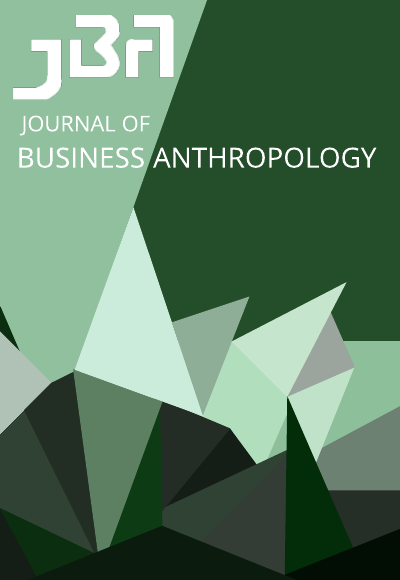Using Boundary Objects to Facilitate Culture Change and Integrate a Global Top Management Team
DOI:
https://doi.org/10.22439/jba.v7i1.5491Keywords:
Organizational change, boundary objects, change implementation, research processAbstract
As business anthropologists, we are often called upon to work on organizational change initiatives as members of a change team. This article is the story of one organizational change initiative involving a global top management team in a healthcare division of a large multinational firm and the research that was used as the basis for implementing change in the top management team and subsequently in the division as a whole. Specifically, the article focuses on how the change team, of which I was a part, communicated the research results to the top management team and to employees of the company by presenting the results in a map that became a boundary object, that facilitating translation across diverse groups, joint sensemaking, and local action in the change process.
References
Bass, Bernard M, and Ronald E Riggio 2006 Transformational leadership: Psychology Press.
Bass, Bernard M. 1999 Two Decades of Research and Development in Transformational Leadership. European journal of work and organizational psychology 8(1):9-32. https://doi.org/10.1080/135943299398410
Bergman, M., K. Lyytinen, and G. Mark 2007 Boundary objects in design: An ecological view of design artifacts. Journal of the Association for Information Systems 8(11):546-568. https://doi.org/10.17705/1jais.00144
Cacciatori, E. 2008 Memory objects in project environments: Storing, retrieving and adapting learning in project-based firms. Research Policy 37(9):1591-1601. https://doi.org/10.1016/j.respol.2008.04.028
Carlile, P. R. 2002 A pragmatic view of knowledge and boundaries: Boundary objects in new product development. Organization Science 13(4):442-455. https://doi.org/10.1287/orsc.13.4.442.2953
Feldman, M. S., et al. 2006 Ways of knowing and inclusive management practices. Public Administration Review 66:89-99. https://doi.org/10.1111/j.1540-6210.2006.00669.x
Gluesing, Julia 1998 Building connections and balancing power in global teams: toward a reconceptualization of culture as composite. Anthropology of Work Review 18(2):18-30. https://doi.org/10.1525/awr.1998.18.2-3.18
Gluesing, Julia, et al. 2003 The development of global virtual teams. In Virtual teams that work: creating conditions for virtual team effectiveness. C.B. Gibson and S. Cohen, eds. Pp. 353-380. San Francisco: Jossey-Bass.
Gluesing, Julia C., and C. Gibson 2004 Designing and Forming Global Teams. In Handbook of Research on International Organizing and Managing. M.L.M. In H. Lane, M. Mendenhall ed. Pp. 199-226. Oxford: Blackwell.
Levina, N., and E. Vaast 2005 The emergence of boundary spanning competence in practice. implications for implementation and use of information systems. Mis Quarterly 29(2):335-363. https://doi.org/10.2307/25148682
Levina, N., and E. Vaast 2006 Turning a community into a market: A practice perspective on information technology use in boundary spanning. Journal of Management Information Systems 22(4):13-37. https://doi.org/10.2753/MIS0742-1222220402
Macpherson, A., and O. Jones 2008 Object-mediated learning and strategic renewal in a mature organization. Management Learning 39(2):177-201. https://doi.org/10.1177/1350507607087580
Starr, S., and J. Griesemer 1989 Instutional ecology, translations and boundary objects: Amateurs and professionals on Berkeley's museum of vertebrate zoologie. Social Studies of Science 19(3):387-420.
Straus, Anselm, and Juliet Corbin 1990 Basics of qualitative research. Grounded theory procedures and techniques.
Trompette, Pascale, and Dominique Vinck 2009 Revisiting the notion of boundary object. Revue d'anthropologie des connaissances 3(1):3-25.
Wenger, Etienne 2000 Communities of practice and social learning systems. Organization 7(2):225-246. https://doi.org/10.1177/135050840072002
Downloads
Published
Issue
Section
License
Authors who publish with this journal agree to the following terms:
- Authors retain copyright and grant the journal right of first publication with the work simultaneously licensed under a Creative Commons Attribution License that allows others to share the work with an acknowledgement of the work's authorship and initial publication in this journal.
- Authors are able to enter into separate, additional contractual arrangements for the non-exclusive distribution of the journal's published version of the work (e.g., post it to an institutional repository or publish it in a book), with an acknowledgement of its initial publication in this journal.
- Authors are permitted and encouraged to post their work online (e.g., in institutional repositories or on their website) prior to and during the submission process, as it can lead to productive exchanges, as well as earlier and greater citation of published work (See The Effect of Open Access).



